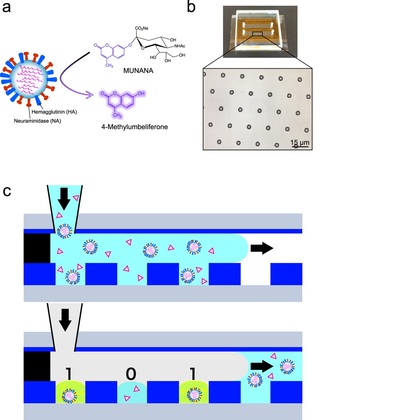Share this
Authors
Kazuhito V. Tabata, Yoshihiro Minagawa, Yuko Kawaguchi, Mana Ono, Yoshiki Moriizumi, Seiya Yamayoshi, Yoichiro Fujioka, Yusuke Ohba, Yoshihiro Kawaoka, and Hiroyuki Noji
Abstract
There is large demand for a quantitative method for rapid and ultra-sensitive detection of the influenza virus. Here, we established a digital influenza virus counting (DIViC) method that can detect a single virion without antibody. In the assay, a virion is stochastically entrapped inside a femtoliter reactor array device for the fluorogenic assay of neuraminidase, and incubated for minutes. By analyzing 600,000 reactors, the practical limit of detection reached the order of 103(PFU)/mL, only 10-times less sensitive than RT-PCR and more than 1000-times sensitive than commercial rapid test kits (RIDTs). Interestingly, neuraminidase activity differed among virions. The coefficient of variance was 30–40%, evidently broader than that of alkaline phosphatase measured as a model enzyme for comparison, suggesting the heterogeneity in size and integrity among influenza virus particles. Sensitivity to oseltamivir also differed between virions. We also tested DIViC using clinical gargle samples that imposes less burden for sampling while with less virus titre. The comparison with RIDTs showed that DIViC was largely superior to RIDTs in the sensitivity with the clinical samples although a few false-positive signals were observed in some clinical samples that remains as a technical challenge.

Scientific reports : https://www.nature.com/articles/s41598-018-37994-6
These Related Stories